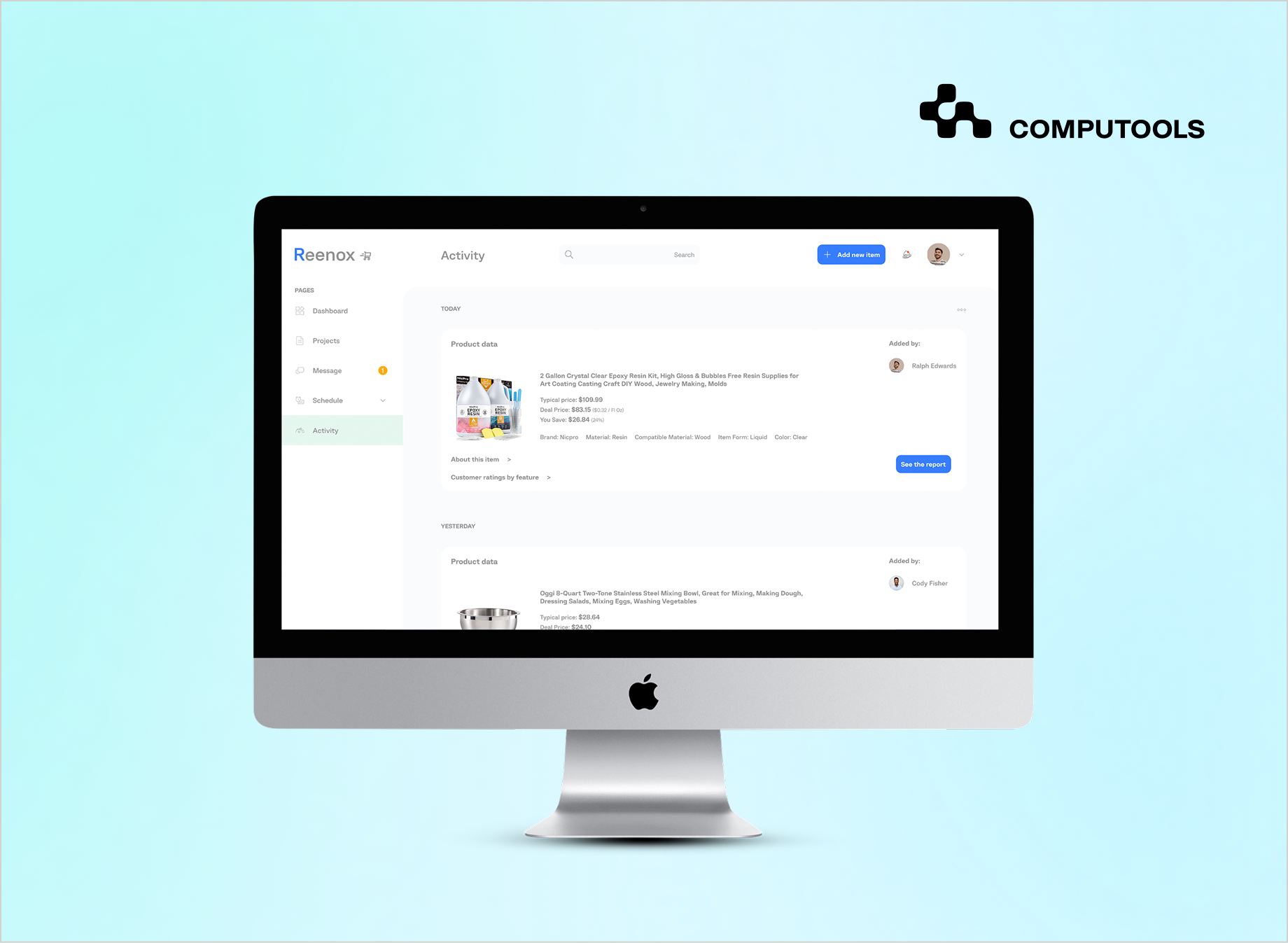Retailers that manage multiple sales channels often struggle with fragmented systems, inefficient workflows, and limited visibility across operations. Without a centralized platform to build a marketplace app that unifies sales, inventory, and order management, businesses face inventory mismatches,
Poor omnichannel execution can cut retail margins by up to 10%. At the same time, omnichannel consumers already drive about 27% of total retail sales, and companies with strong omnichannel engagement retain 89% of their customers compared to just 33% for weaker strategies.
With Statista projecting global marketplace sales to surpass $8.7 trillion in 2025, the pressure on retailers to stay competitive has never been higher.
At Computools, we’ve already guided multiple retailers through this transformation. Our portfolio includes more than 20 retail projects, from marketplaces and mobile commerce apps to omnichannel platforms. With deep expertise in retail software development services, we help clients replace fragmented tools with scalable, unified systems powered by real-time analytics.
By developing multi-vendor marketplace apps, we have tackled everything from complex vendor management to creating positive customer experiences. That’s why we apply both theory and proven practice to this field.

How we developed a custom marketplace management app for the largest retail store chain in the United States
Talking about expertise, we have faced these challenges alongside our clients. We built a custom marketplace app for the largest U.S. retail chain, turning complexity into measurable growth. By combining our expertise in mobile app development services with a tailored eCommerce software solution, we delivered a centralized platform for product management, data analysis, and trading.
The result was a 20% increase in productivity, with real-time analytics and inventory control enabling faster, data-driven decisions. This example shows how Computools helps retailers replace fragmented systems with scalable marketplace platforms, boosting efficiency, lowering costs, and creating new revenue streams.

How to build a custom marketplace management app for retailers: 11-step guide
To build marketplace app systems that truly scale, retailers need more than just basic eCommerce features; they need retail marketplace app solutions designed to unify inventory, vendors, and customer experience in one platform.
The process involves aligning business goals with technology, choosing the proper architecture, and ensuring seamless integrations that support omnichannel growth. Here are 11 steps on how to build a custom marketplace application.
Step 1. Define your niche & audience
To build marketplace app systems that work, start by defining a precise niche and audience. A marketplace wins when it solves specific pains for real users, vendors, operators, and buyers, not “everyone.” Map their jobs-to-be-done, frustrations, and success metrics to set a clear value proposition.
When we created custom marketplace software for retailers (Reenox case) for the largest U.S. retail chain, this step was decisive. By analyzing the needs of sellers, store managers, and analysts, we focused the product on real-time visibility, simplified workflows, and actionable analytics. That user alignment became the platform’s foundation and contributed to a 20% increase in marketplace productivity.
Step 2. Validate your marketplace idea
Defining a niche is only the first step; the next challenge is to prove that your marketplace concept works in practice. Validation means checking whether your assumptions about demand, monetization, and user behavior hold. This includes lean market research, pilot testing, and structured customer interviews that reveal real expectations and pain points.
By running this process early, you minimize the risk of investing in features nobody needs and instead build around what your audience truly values.
For example, in the Reenox project, validation showed that the client’s existing revenue model was effective, but the lack of a unified operational backbone slowed growth. That insight guided the development strategy and confirmed building a custom marketplace app was the right path for long-term scalability and business impact.
Step 3. Choose your marketplace business model
Once you build an application, defining a clear monetization strategy is key to long-term success. The most common revenue streams include transaction fees (a percentage per sale), listing fees (charges for publishing products), and subscription plans (recurring payments for premium access). Many retailers add ads, promoted listings, or fulfillment services as scalable revenue streams.
The right approach depends on how users interact with your platform. A well-structured online marketplace management system makes aligning the revenue model with real user behavior easier.
For example, the marketplace app didn’t reinvent monetization in our Reenox project for a leading U.S. retailer. Still, streamlined existing commission-based flows with real-time transparency, helping the client scale proven revenue models while reducing inefficiencies.
Step 4. Plan your budget wisely
One of the most overlooked parts of marketplace projects is budgeting. Instead of funding a complete platform immediately, starting with an MVP focusing on essential workflows is more effective. This approach lowers risks, accelerates time-to-market, and ensures that every dollar supports real outcomes.
Typical cost areas include discovery, research, core development, post-launch support, and scaling. Careful planning of these stages helps avoid overspending and ensures investments deliver measurable results.
In the Reenox case, our expertise in retail app development allowed us to design a modular architecture. This gave the client a faster launch, validated their monetization model, and created room to expand with advanced analytics and integrations without disrupting daily operations.
Step 5. Define your marketplace MVP functionality
Focusing on the MVP stage is essential when moving into eCommerce software development. Instead of overloading the platform with features, select the core functionality that delivers the most value and validates product–market fit.
These include:
• Product listings & search for quick browsing,
• Payments & checkout with secure gateways,
• Ratings & reviews to build trust,
• User registration & login with strong security,
• Buyer–seller messaging for direct communication.
In the Reenox case, we applied this approach by launching with trading and analytics essentials. This allowed the client to test their monetization model, gain adoption, and then scale with advanced features.
Step 6. Create wireframes and design the UI/UX
Once core features are defined, the next step to build marketplace app systems is shaping how they look and work for users. Wireframes and prototypes help visualize user journeys, while the UI/UX design ensures intuitive navigation and seamless engagement. Good design minimizes friction, keeps users loyal, and drives transactions.
For Reenox, our team crafted interfaces that made it easy to manage large data volumes while keeping navigation simple. By blending functionality with user-friendly design, we delivered a marketplace platform that worked as well as it looked.

Step 7. Design of architecture and database
Behind every thriving marketplace lies a robust architecture. The technical team defines the system structure based on business requirements as a three-tier setup, microservices, or hybrid model. A well-chosen software architecture ensures scalability, performance, and security at every stage. Database design plays a key role too, with measures like data encryption, access control, and secure transactions protecting user and payment information.
In the Reenox case, we implemented a modular architecture that supported rapid scaling, real-time analytics, and integrations with existing retail systems, helping the client stay agile while managing massive transaction volumes.
Step 8. Develop a functional system
Once the architecture is set, extending functionality beyond the MVP is where the marketplace evolves into a full-scale retail engine.
These may include:
• Inventory & supply chain tools for accurate stock management,
• Seller portals for vendor autonomy,
• Marketing features like promotions, live ads, or gamification
• Analytics dashboards to track performance and shape strategy.
In Reenox, we built custom operator and seller portals with marketplace inventory management app capabilities and data-driven insights. This helped the retailer streamline operations, cut overhead, and deliver transparency to all stakeholders.
Step 9. Quality assurance and testing
Testing is critical to validate that the marketplace operates as intended. This includes functional testing, UI/UX checks, browser compatibility, performance load tests, and security audits.
Compliance with GDPR, PCI DSS, and local regulations should also be verified at this stage to avoid risks and ensure vendor and customer trust. Every detail matters, from payment workflows to data protection protocols.
In the Reenox project, rigorous QA cycles helped eliminate bottlenecks before launch, ensuring the app could handle high transaction loads with zero downtime.
Step 10. Go-live and launch
With development and testing complete, the platform moves to production. This involves preparing hosting environments, migrating data, finalizing integrations, and configuring domains. Close monitoring in the first weeks ensured system stability and gave the client confidence in scaling operations globally.
The Reenox marketplace went live after a thorough checklist process: environment setup, final data validation, and employee training. By the time of launch, the system was fully stable, performance-optimized, and ready for global traffic.
Step 11. Continuous updates & feature growth
Marketplace success doesn’t stop at launch. Regular updates ensure the platform evolves with customer needs, industry trends, and security requirements. New features, from AI-powered recommendations to advanced reporting, help businesses stay ahead of competitors. Ongoing compliance audits (GDPR, PCI DSS) and security patches strengthen trust and protect sensitive data.
In Reenox, continuous updates expanded functionality with marketplace analytics and reporting tools, enabling the client to make smarter decisions, personalize user experience, and identify new revenue opportunities. This proactive approach turned the marketplace into a living system that grows stronger over time.

Retailers adopting custom marketplace apps report up to a 30% sales uplift. Now’s the time to seize that growth.
Why build marketplace app: benefits and challenges for retailers
Step 11 reminds us that marketplaces are constantly evolving. With that in mind, it’s time to consider the bigger picture—what retailers stand to gain and the challenges they must overcome.
| Challenges | Benefits |
| Higher upfront investment. Custom development costs more than SaaS subscriptions at the start. | Tailored functionality. With modern marketplace software solutions for retailers, businesses get features designed for their workflows instead of generic tools. |
| Complex integrations. Legacy ERP or inventory systems may require additional middleware or custom connectors. | Seamless integrations. CRM, POS, payment gateways, and analytics tools connect into one ecosystem. |
| Longer time-to-market. Even with Agile, a custom app takes months compared to off-the-shelf solutions. | Scalability and growth. The app can expand from hundreds to thousands of vendors, categories, and markets. |
| Responsibility for data management. Security patches, new features, and infrastructure scaling require continuous investment. | Data ownership and insights. All product, customer, and transaction data belong to the retailer, enabling deep analytics. |
| Talent gap. Not every retailer has internal expertise to manage security, compliance, and large-scale marketplace operations. | Enhanced security and compliance. With the right partner and experienced marketplace app developers, PCI DSS, GDPR, and local regulations can be built in from the start. |
Global trends in marketplace app development
The five global trends in marketplace app development below influence the future of digital commerce for retailers and technology leaders.
1. Marketplace dominance & GMV growth
In 2024, the top 100 global marketplaces reached $3.83 trillion in GMV, a ~10% increase compared to 2023. Online marketplaces already accounted for 62% of global eCommerce sales, showing how the third-party (3P) seller model is becoming dominant.

2. Retail eCommerce growth & mobile transformation
Global retail eCommerce sales are projected to reach $6.4–8.3 trillion in 2025, representing about 20–21% of total retail spending. Mobile commerce will play the leading role, with over 70% of online purchases made via mobile devices by 2025.
3. Niche and vertical marketplaces + business model diversification
There is a growing demand for specialized platforms in fashion, healthcare, and eco-friendly products. Marketplaces are expanding into new verticals such as logistics, fintech, advertising, and loyalty programs.
In 2024, marketplaces already accounted for 49% of FMCG eCommerce sales, highlighting their penetration even into fast-moving consumer categories.
4. AI, personalization & automation
Around 50% of retail and e-commerce professionals plan to invest in AI, business process automation, personalization, and supply chain optimization by 2028. Marketplaces apply recommendation engines, dynamic pricing, intelligent search, and chatbots to meet user expectations and compete with global giants.
5. Cross-border expansion
More than half of global online shoppers purchase from cross-border stores. Marketplaces use this as a growth driver, expanding into new regions, optimizing logistics, and adapting payment processes to attract international customers.
Amid these shifts, the role of reliable marketplace app development companies becomes crucial. They provide the expertise to align technology with evolving trends, ensuring retailers can scale, compete, and deliver seamless customer experiences.
For a deeper understanding of how artificial intelligence is changing online retail, from recommendation engines to logistics optimization, see Computools’ article on AI in eCommerce: Big Changes in Business Landscape.
Top 7 marketplace app leaders
Below are some top marketplace apps that have become industry leaders, offering users easy access to various products and services from multiple sellers.
| Company | Description | Revenue (Approx.) |
| Amazon | Since 1994, Amazon has redefined global eCommerce, generating $638B in net sales revenue in 2024. Around 60% of paid units come from third-party sellers, while logistics services like fulfilled by Amazon (FBA) manage roughly half of orders. With over 100 acquisitions (including Whole Foods for $13.7B), Amazon expanded into logistics, AI development, and cloud computing. It processes nearly 6B packages annually in the U.S., invests in AI-powered automation, and is testing Prime Air drone delivery. | $638B (2024) |
| eBay | The platform remains Amazon’s second most visited online marketplace in 2024. eBay reported $10.4B annual revenue at its peak (2021) and continues to expand via acquisitions such as Certilogo (AI authentication), TCGPlayer (trading cards), and Known Origin (NFTs). | $10.4B (peak) |
| Airbnb | Airbnb transformed travel by connecting guests with hosts worldwide. By 2024, it had 5M+ hosts, 1.5B lifetime guest check-ins, and 490M nights/experiences booked in a year. Revenue reached $11B in 2024. In 2025, Airbnb ranked as the third most visited travel site globally and was among the most downloaded travel apps. | $11B (2024) |
| Etsy | Etsy became the leading niche marketplace for handmade, vintage, and craft goods with a mission to “keep commerce human.” By 2023, it had 9M+ sellers and 95M active buyers worldwide. Annual GMS peaked during the pandemic, reaching nearly $5B in 2019, with revenues growing despite a slight decline in seller base (2024: ~8M sellers). Etsy’s ecosystem includes Depop and Elo7, while Reverb was sold in 2025 to refocus on core marketplaces. | $2.6B |
| Uber | A service-based marketplace operating in 70 countries. By 2023: 150M monthly users, 9.4B trips, $37B net revenue, and $37.6B in quarterly gross bookings. | $37B |
| Booking Holdings Inc | The world’s largest online travel agency operates Booking.com, Priceline, Agoda, Kayak, and OpenTable. In 2024, Booking Holdings reported $24B revenue and over 1.1B room nights booked. Booking.com was the most visited travel website in 2025, with 4× more traffic than Tripadvisor. | $24B |
| Aliexpress | Launched in 2010 as Alibaba’s B2C international brand, AliExpress connects Chinese sellers with global buyers. By 2023, fashion accounted for 30% of GMV, with the U.S. responsible for nearly 20% of transaction volume. The platform is part of Alibaba’s international commerce segment, which has grown 20× in the past decade. AliExpress remains a pioneer of cross-border eCommerce, but faces rising competition from Shein and Temu | $130B+ (Alibaba Group annual revenue, 2024) |
These examples show how the marketplace model adapts across industries from retail and travel to services and niche products. Each platform demonstrates that scalability, user trust, and flexibility are vital for long-term success.
Choosing the right partner for the marketplace management app development
Successful marketplace management app development requires more than coding. It means aligning technology with retail business models, workflows, and customer experience. Choosing the right partner determines whether your marketplace becomes a scalable strategic asset or a costly experiment.
What to look for in a partner:
• Proven retail expertise: real cases of managing large ecosystems and delivering multivendor marketplace management software.
• Security and scalability know-how: experience with PCI DSS, GDPR, and cloud-native architectures.
• Custom-fit development: a team of app developers who adapt solutions to unique workflows instead of relying on one-size-fits-all approaches.
• Transparent collaboration and support: long-term maintenance, agile delivery, and ongoing upgrades after launch.
Even with a clear roadmap, success relies on choosing the right tech partner. If you’re considering options, review our detailed list of the 10 Best Marketplace App Development Companies for Retailers in 2025.
Why Computools is the best choice
Computools brings together 250+ engineers and a track record of 400+ projects in retail, finance, logistics, and beyond. The company holds ISO 9001 and ISO 27001 certifications, proving process maturity and security standards. Trusted client testimonials further validate the company’s reliability and success.
A standout case is the Reenox platform, built for a global US-based retail chain. The challenge was to unify marketplace operations, streamline product data management, and enable advanced analytics. Computools delivered a modular architecture with real-time inventory tracking, data pipelines, and an intuitive interface for sellers, store managers, and end users.
Key results:
• +20% increase in productivity through optimized processes and unified workflows.
• Reduced stock-outs and overstocking with real-time analytics.
• A centralized platform that supports expansion into new regions without major rework.
This project demonstrated how the right partner turns marketplace software into a strategic growth driver with measurable ROI.

Investing in marketplace software goes beyond creating a digital presence; it establishes a foundation for long-term competitive advantage.
Conclusion
Marketplaces define who leads in modern retail. Custom marketplace app development gives retailers a platform that unifies operations, strengthens customer trust, and drives sustainable growth. With Computools, businesses gain the expertise to harness real-time data and confidently expand into new markets.

Computools
Software Solutions
Computools is a digital consulting and software development company that delivers innovative solutions to help businesses unlock tomorrow.









“Computools was selected through an RFP process. They were shortlisted and selected from between 5 other suppliers. Computools has worked thoroughly and timely to solve all security issues and launch as agreed. Their expertise is impressive.”